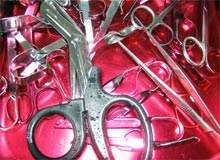
The low cost of sterilisation wraps and an increase in hospital and surgery centres is likely to contribute to 3% annual growth in this market, which is increasing in importance due to a rising emphasis on healthy hospitals.
The sterilisation of surgical equipment and supplies helps minimise the spread of infections to patients in hospital. Today it is common practice that clamps, scalpel blade handles, retractors, forceps and scissors are placed on an instrument tray and packaged within at least one layer of a sterilisation wrap. This wrap is then sealed, all the time cleaning the objects, until they are required again for use.
The US Food and Drug Administration (FDA) recently changed the guidelines for sterilisation packaging, which includes wraps.
The FDA guidance now requires maintenance of package integrity (MPI) testing for all sterilisation packaging products which requires the recording of both events and time to determine the integrity of a sterilised package.
Companies such as Kimberley Clark had previously tested event-related sterility maintenance separate from time-related sterility maintenance. The more vigorous MPI test combines the two tests into a single protocol.
See Also:
The US market alone for sterilisation wraps was valued at $150m in 2009, and is forecast to grow at a CAGR of 3% to reach $180m in 2016. In the US, about 80% of hospitals use sterilisation wraps. In Europe, about 60% of the hospitals use sterilisation containers with the remaining 40% using sterilisation wraps. European hospitals’ preference for sterilisation containers is because they are environmentally friendly compared to sterilisation wraps.
How well do you really know your competitors?
Access the most comprehensive Company Profiles on the market, powered by GlobalData. Save hours of research. Gain competitive edge.

Thank you!
Your download email will arrive shortly
Not ready to buy yet? Download a free sample
We are confident about the unique quality of our Company Profiles. However, we want you to make the most beneficial decision for your business, so we offer a free sample that you can download by submitting the below form
By GlobalDataImportant attributes of sterilisation wraps include:
- high strength
- an effective barrier
- low lint.
- easy aseptic presentation
- water resistance
- steam and ethylene oxide penetration
- shelf life and event-related sterility maintenance.
Competitive landscape
In the US, about 75–80% of hospitals use sterilisation wraps with the rest using sterilisation containers. Sterilisation wraps are disposable after a single use and are also inexpensive compared to sterilisation containers. This is leading to increasing adoption of sterilisation wraps by US hospitals.
In 2009 Kimberly Clark, with a 92% share, was the dominant player in the US sterilisation wraps market. The company’s agreements with leading distributors and group purchasing organisations such as Cardinal Health and Premier Purchasing Partners is leading to a sustained and dominant position in the market.
Medline Industries had a 4% share and other companies such as Arjo Wiggins and Ahlstrom also have a presence in the US sterilisation wraps market.
The European market for sterilisation wraps was valued at $70m in 2009 and is forecast to grow at a CAGR of 1% to reach $74m in 2016. European hospitals’ preference for sterilisation containers is leading to a nominal growth in the sterilisation wraps market.
The market here is highly competitive, with multiple players having a strong presence. In 2009 Kimberley Clark, with a 40% share, was the leader followed by Ahlstrom (25%) and Arjo Wiggins (15%).
Others include companies such as Medline Industries and Baxter Healthcare.
Driving the market
The construction of new hospitals in the US is expected to drive the sterilisation wraps market in the future. More than 3,000 projects (including hospitals and outpatient clinics) are under development in the US. An increase in the number of surgery centres is expected to increase demand even more.
Nosocomial bloodstream infections are a leading cause of death in the US. Assuming a nosocomial infection rate of 5%, of which 10% are bloodstream infections, and a mortality rate of 15%, they would represent the eighth leading cause of death. Because most risk factors are very difficult to change, hospitals are focusing on prevention techniques such as using disposables.
In Europe, only about 40% of hospitals use sterilisation wraps and the rest use sterilisation containers. Hospitals in Europe are more environmentally conscious, and sterilisation wraps are not environmentally friendly as they are made of non-woven polymers and are disposable. In addition, sterilisation containers are cost effective in the long term despite being expensive during the initial purchase. This is also a factor in the decision to choose sterilisation containers in European hospitals.
This article – Sterilization Wraps: A Market Snapshot –was first published by GlobalData. To purchase a copy please visit http://www.medicaletrack.com/Home.aspx.



